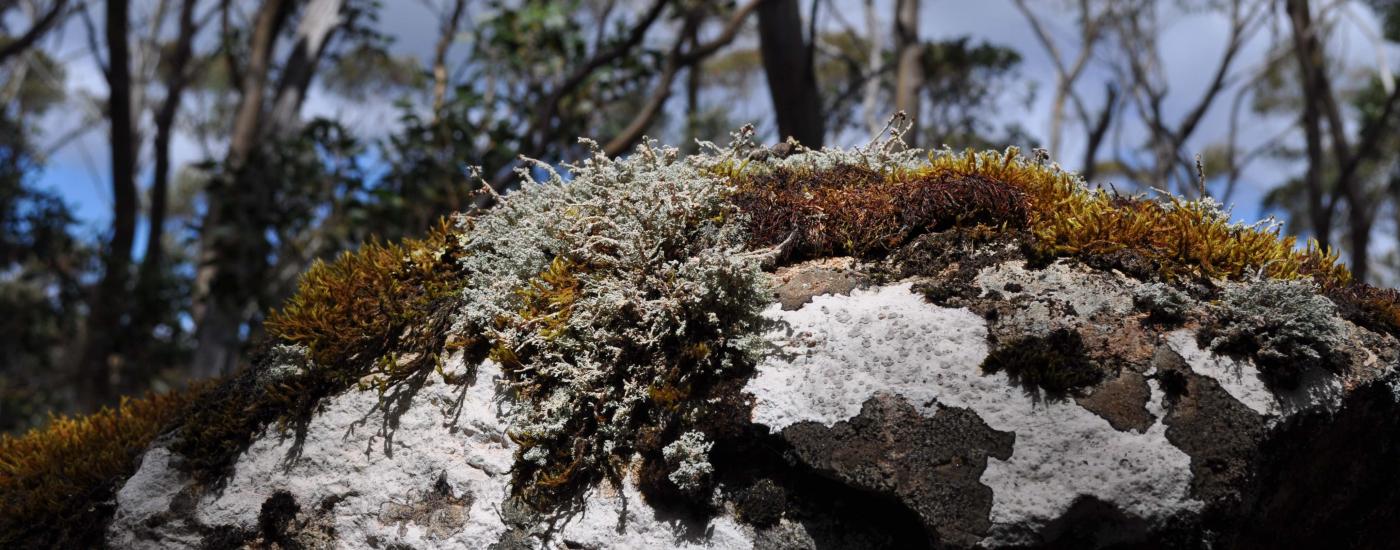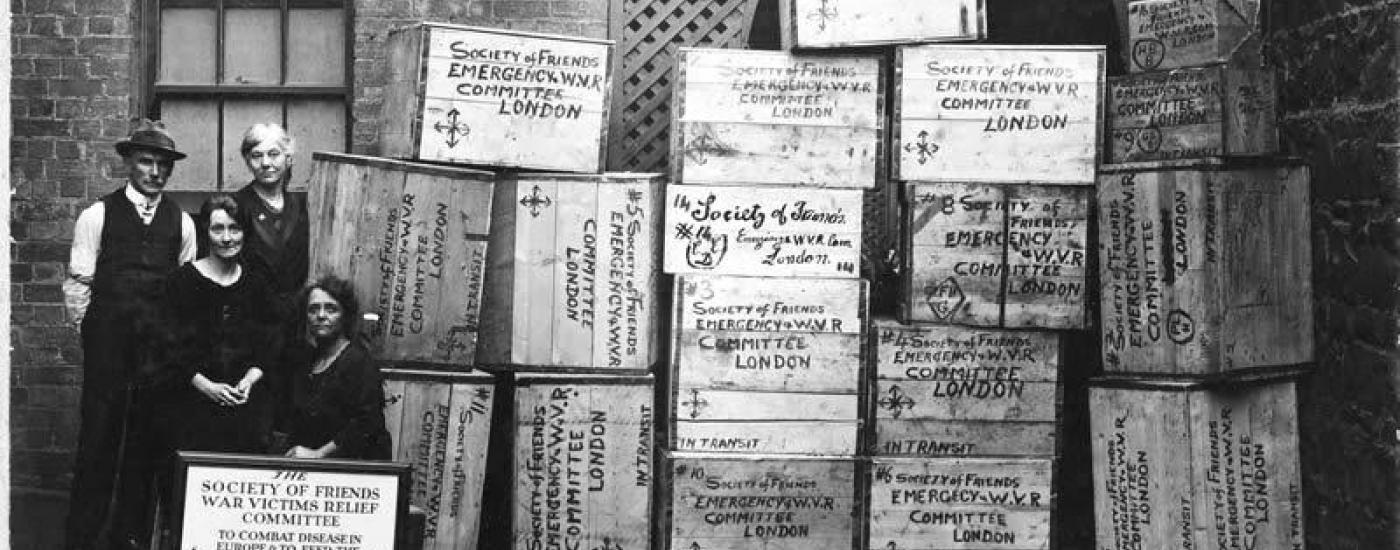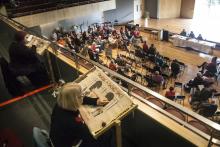
When the bible was translated into English in the 17th century it became available to a much wider audience. People realised that the practices of the established church were not what was in the bible. It does not say anything about churches, cathedrals, clergy, popes, consecrated ground, fixed forms of service, hymns, etc.
One of those people was George Fox who travelled around England pointing out that Jesus said “when two or three are gathered together there am I” (Matthew 18:20).
Supported by a friend Margaret Fell they formed the Religious Society of Friends of the Truth - later shortened to the Religious Society of Friends and subsequently given the nickname Quakers.
Quakers effectively did away with the whole structure of the conventional churches and went back to that basic belief. We all have something within us, which many call God, that we can access and share with others.
Religious turmoil in 17th century England resulted in large numbers of Quakers ending up in prison and also many emigrated to America. Pennsylvania was founded by Quakers.
We are not connected with the Puritans or the Amish - a common assumption by people who don’t know us.
Many of the earliest British settlers in Australia (including convicts) were Quakers.
Although their main concerns were the treatment of the convicts and of the Aborigines, they also travelled around Australia contacting as many Quakers as they could. This resulted in the formation of a formal Quaker group in Hobart, where they were mainly based, and later, groups in other States.
Quaker congregations are called Meetings and, confusingly, the word can refer to the act of meeting together (for worship or business) as well as the organisation. We have seven Regional Meetings in Australia - which conduct business, normally monthly, in relation to their area, and Australia Yearly Meeting, which meets for business for the whole of Australia once a year.
For many years Quakers were associated with their home Meetings in England and it was not until 1964 that Australian Quakers became independent of Britain and formed their own Australia Yearly Meeting.
There are about 2,000 Quakers in Australia, about half of whom are Members and the other half regularly attend our meetings. There are many others who come occasionally, and we welcome them all.
There is more information about our history here and information about the Quaker witness to peace and non-volence during WWI here. We also have biographical information about over 1,350 Australian Quakers who have died which could be useful for family history research.
Our History

Image: Mt Field National Park, Tasmania, Emily Chapman-Searle
The Religious Society of Friends had its origin in England in the seventeenth century. It sprang from the religious experience of George Fox, but numbers of Seekers had already separated themselves from the churches and were meeting together for worship without any ordained priests or ministers, and without the use of any rites such as baptism or the eucharist. The basis of their worship was silently waiting upon God. Many of the Seekers turned to Fox as their leader, and in course of time the Religious Society of Friends emerged.
The First Quakers in Australia
The first Quaker on Australian soil was Sydney Parkinson, an artist employed by the botanist Joseph Banks, sailing with James Cook. They landed briefly in 1770.
Sending convicts to British colonies was introduced by King Charles II of England 'for preventing dangers that may arise from certain persons called Quakers'. But very few of the Convicts sent to Botany Bay were Quakers, they were usually sad cases who would now be treated for alcoholism or mental illness. However, two Quakers appear in the NSW muster (census) of 1828.
English Quaker Elizabeth Fry and her helpers visited every convict ship of women prisoners. They provided them with something useful to do on the long tedious voyage to Botany Bay, such as needles and cotton and handiwork.
It was not until 1832 that the Society first took root in Australia, as a result of a visit by two English Friends, James Backhouse and George Washington Walker. They were sent by British friends on a six-year journey around south-east Australia to enquire into the condition of the penal settlements and the welfare of the Aborigines and free settlers. They also drew together the few members of the Society in Van Diemen's Land and New South Wales in regular Meetings for Worship.
The number of Friends in Australia increased during the 1850's at the end of the gold rush decade, and in 1861 London Yearly Meeting formally recognised the Meetings in Hobart, Melbourne and Adelaide. Later came recognition of the Meetings in Sydney, Brisbane, Rockhampton and Ballarat.
By the 1880s Quakers had established The Friends' School in Hobart, the Elizabeth Fry retreat for 'fallen women' in Melbourne, and the Gospel Temperance Hall in Adelaide. The Peace Movement was launched in 1888.
Initially, a General Meeting for Australia was established as a Quarterly Meeting of London Yearly Meeting. In 1964, under the Clerkship of David Hodgkin, Friends in Australia became an independent Yearly Meeting with its own Handbook of Practice and Procedure.
Quaker Biographies
The Australian Quaker Biographies page includes information about nearly 1,400 people who have been associated with Quakers in Australia over the last 200 years, as well as a few international Quakers.
Quakers in Australia Today
There are about a half a million Quakers worldwide. In Australia, there are around 1000 members and about 1000 attenders, i.e. people who worship with Quakers regularly but who have not applied for membership. Quakers continue to take action for peace and justice for all people, and the service arm, Quaker Service Australia provides development assistance within Australia, Asia and Africa.
Other Resources for Quaker History
The National Library of Australia holds archives on Australian Quakers, as does the University of Tasmania.
The History & Origin of Quakers is a comprehensive document by Monika Smith, from NSW Regional Meeting.
Quakers in Brief is an over-view of the Quaker movement from 1650 to 1990, by David M. Murray-Rust, Birkenhead Meeting, Merseyside, UK 1995.
The World War I Exhibition illustrates the experience of Quakers facing the challenges of WW1. It pays tribute to the courage of those people and communities (not just Quakers) who expressed their faith and conviction in opposing war and in working for peace, and highlights the need for our continuing commitment to peace-making and nonviolent resolution of conflicts. This exhibition was prepared in 2014 by the Religious Society of Friends (Quakers) in NSW.
The article Paxton, a haven of peace during WWII, by Bill Metcalf, about a small Quaker commune, known as Paxton (peace-town, or place-of-peace) near Brisbane Queensland started in 1940, which provided a safe haven for Australian conscientious objectors seeking to avoid conscription, and for respite following terms of imprisonment.
The article Friends Farm: Australia's first Quaker commune , by Bill Metcalf, published in the Journal of Religious History, which was established in 1869 on what is now Queensland’s Sunshine Coast. This group was led by Alfred Allen, a Quaker from Sydney.
Exhibitions

Learn more about our Quakers in The World War I Exhibition, as well the Australian Quaker Narrative Embroidery (Friends in Stitches) panels, which are toured to Quaker meetings and other venues in Australia.
The World War I Exhibition
The World War I Exhibition illustrates the experience of Quakers facing the challenges of WW1. It pays tribute to the courage of those people and communities (not just Quakers) who expressed their faith and conviction in opposing war and in working for peace. It highlights the need for our continuing commitment to peace-making and nonviolent resolution of conflicts.
The Exhibition has been displayed at a number of venues, including Yearly Meetings at various sites across Australia, as well as at libraries, churches and festivals in NSW, Victoria, Tasmania, ACT, South Australia and Western Australia since 2014.
The panels are:
- World War One Exhibition Introductory Panel
- Part 1 - Who Are The Quakers?
- Part 2 - Bearing Witness for Peace
- Part 3 - Challenging Pre-World War I Militarism
- Part 4 - Child Conscription
- Part 5 - Dissent to War
- Part 6 - Women and Dissent
- Part 7 - Quaker Relief Work
- Part 8 - War and Its Aftermath
- Part 9 - Continuing Witness for Peace
- Part 10 - Quaker Witness Today
Also included is a Resource Guide: World War 1: Quaker Witness to Peace and Nonviolence
This exhibition was prepared in 2014 by the Religious Society of Friends (Quakers) in NSW. (Design by ARMEDIA Pty Ltd.)
Australian Quaker Narrative Embroidery Project Exhibition
 These panels are being created to illustrate Australian Quaker history and concerns. The Friends in Stitches Committee coordinates the design, stitching and conservation and exhibition of the panels which tour to various Australian Quaker meetings and provide a great source of outreach about the Australian Quaker story.
These panels are being created to illustrate Australian Quaker history and concerns. The Friends in Stitches Committee coordinates the design, stitching and conservation and exhibition of the panels which tour to various Australian Quaker meetings and provide a great source of outreach about the Australian Quaker story.
